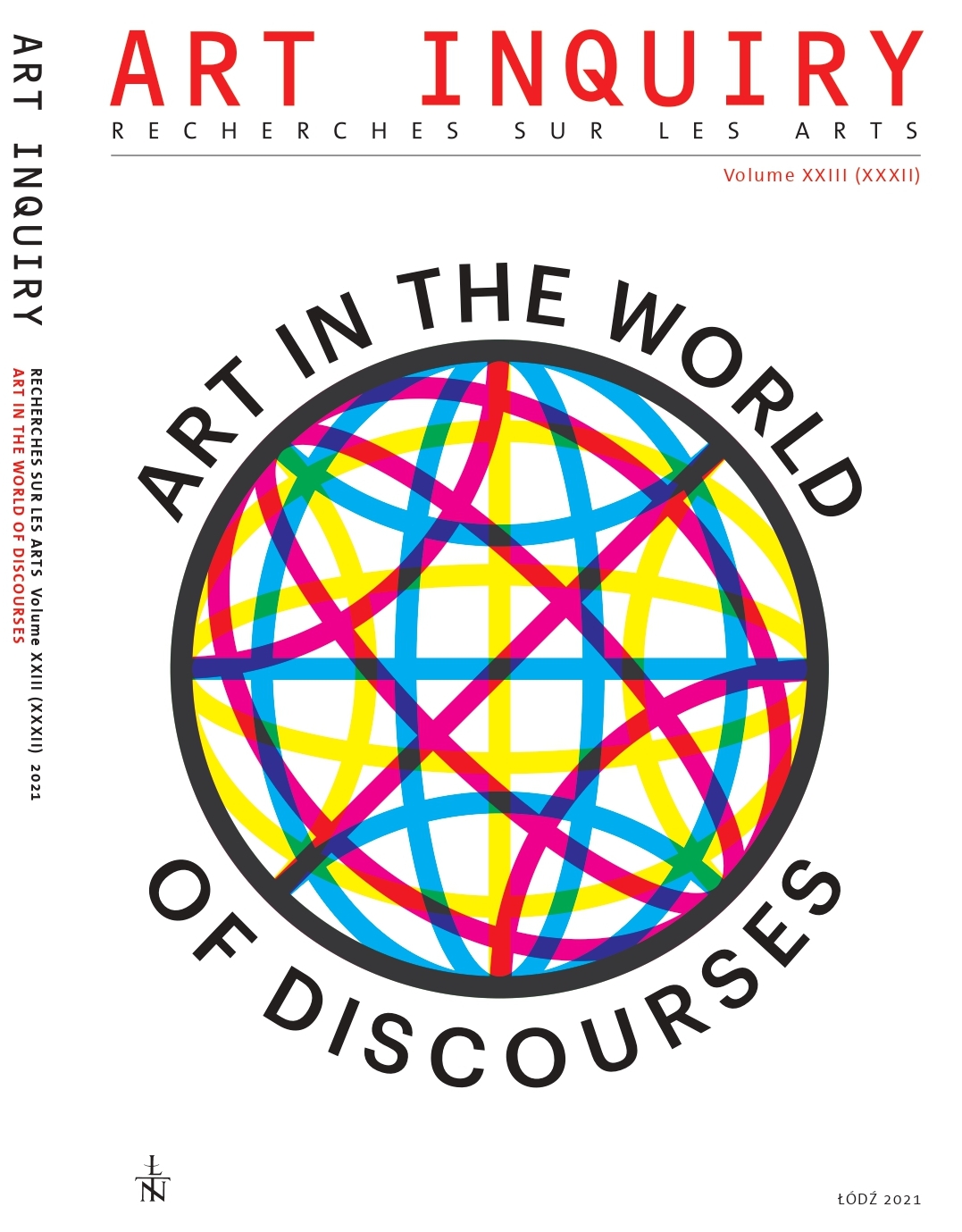Ekologia i sztuka – w sieci dyskursów
DOI:
https://doi.org/10.26485/AI/2021/23/8Słowa kluczowe:
dyskurs sztuki, dyskurs ekologiczny, eko-sztuka, sztuka ziemi.Abstrakt
Sztuka, podobnie jak całe nasze życie publiczne, uwikłane jest w sieć dyskursów. W artykule przedstawiam na przykładzie sztuki związanej z ekologią, jak rozwija się sieć dyskursów i co może być impulsem do tworzenia nowych połączeń. Wskazuję jak dyskursywizacja sztuki rozpoczyna się już od samego nazewnictwa. Prowadzenie refleksji nad siecią dyskursów, wejście na poziom metadyskursu uważam za sposób uwolnienia się z ograniczającej wspólnoty interpretacji, podobnie jak sztukę tworzącą miejsca dla wspólnych działań za sposób wyjścia z niebezpiecznej rywalizacji dyskursów
Bibliografia
Bower Sam, A Profusion of terms, https://www.lindagass.com/PDFs/Unity_June09.3.pdf
Braddock Alan C., (2009), Ecocritical Art History, “American Art”, vol. 23, no. 2, pp. 24-28.
Czachur Waldemar, (2011), Dyskursywny obraz świata, “Tekst i dyskurs – text und diskurs”, no. 4, p. 79-97.
Czerwiński Maciej,(2005) Kultura, dyskurs, znak, Wyd. UJ, Kraków.
van Dijk Theo (2014), Discourse and Knowledge: A Sociocognitive Approach, Cambridge Univeristy Press, Cambridge
Discourse Studies: A Multidisciplinary Introduction (2011) Teun van Dijk Teun (ed.) second ed., Sage Publications, Los Angeles, London, New Delhi, Singapore, Washington.
Fish Stanley (2005), Is there a Text in this Class? The authority of interpretive communities, Cambridge: Harvard University Press.
Foucault Michel, (1981) The Order of Discourse, [in:] Untying the Text: A Post-structuralist Reader, (ed.) Robert Young, Routledge & Kegan Paul, Boston, London, Henley, pp. 51-78.
Grzelka Monika (2009), Dyskurs intelektualny ponad i pomiędzy. Wyd. UAM Poznań.
Guzek Łukasz, Grzegorz Sztabiński, [in:] Katalog Artystów, http://www.artysci-lodzkie.pl/pl/artysta/s/grzegorz-sztabinski/
Howarth David (2000), Discourse, Open University Press, Buckingham, Philadelphia.
Hymes Dell (2001), Foundations in Sociolinguistics: An Ethnographic Approach, Routledge, (reprint) London.
Jakimiak Agnieszka, Interview with Alice Creischer, Susanne Kriemann, Antje Majewski, [Nature Morte spectacle. Premiere: 7th November 2020, Teatr Powszechny in Warsaw], p. [4]; https://artmuseum.pl/public/upload/files/Nature-Morte.pdf
Kagan Sacha (2014), La pratique de l’art écologique, “Plasatik”, no. 4, https://plastik.univ-paris1.fr/la-pratique-de-lart-ecologique/ in English on-line: https://www.researchgate.net/publication/274719395
Kagan Sacha,(2013), Art and Sustainability: Connecting Patterns for a Culture of Complexity, Transcript, Bielefeld.
Kazimieska-Jerzyk Wioletta, (2012), Obraz a idea. Estetyczno-antropologiczne paradoksy sztuki konceptualnej (implikacje ikonoklastyczne). / Image and Idea. Aesthetic and Anthropological Paradoxes of Conceptual Art (Iconoclastic Implications), “Sztuka i dokumentacja”, no. 6, pp. 47-52.
Krueger Rob, (2018) Art, Social Change, and the Green City: A Rebuke of Green Metropolitanization, “RCC Perspectives”, no. 1, GREEN CITY: Explorations and Visions of Urban Sustainability, pp. 81-88.
Lister Rosi, (2003), What is Environmental Art? A strategy for re-cognition, orientation and implementation, “Co-Gen Magazine”, https://www.ecologicalart.org/cogmag20what.html
Luke Timothy W. (1992), Art and the Environmental Crisis: From Commodity Aesthetics to Ecology Aesthetics, “Art Journal", vol. 51, no. 2, pp. 72-76.
Marzec Sławomir,(2018) Krytyka jako (anty)istota dyskursu sztuki, [in:] Teresa Pękala (ed.), Dyskursy sztuki, dyskursy o sztuce, Wydawnictwo UMCS, Lublin 2018, pp. 59-68.
Mullet Dianna R. (2018), A General Critical Discourse Analysis Framework for Educational Research, “Journal of Advanced Academics”, vol. 29(2), pp. 116–142 .
Ostrowicki Michał, Teoria sytuacji estetycznej M. Gołaszewskiej jako fundament estetyki, http://www.sideymyoo.art.pl/old/Teoria_sytuacji_estetycznej.pdf
Pierotti Raymond, Wildcat Daniel (2000), Traditional Ecological Knowledge. The Third Alternative (Commentary), “Ecological Applications”, vol. 10, no. 5, pp. 1333-1340.
Pisarek Walery (2006), Słowa ważne i ważniejsze, “Przegląd Humanistyczny”, no. 3, pp. 11-20.
Roose Henk et al (2018), Trends in Contemporary Art Discourse: Using Topic Models to Analyze 25 years of Professional Art Criticism, “Cultural Sociology”, vol. 12(3), pp. 303-324.
Scott Emily Eliza, Swenson Kirsten (2015), Introduction. Contemporary Art and the Politics of Land Use, in: Critical Landscapes, ed. Emily Eliza Scott and Kirsten Swenson, University of California Press, Oakland.
Scruton Robert (2012), Green Philosophy: How to think seriously about the planet, Atlantic Books, London.
Stalpaert Christe (2018), This body is in danger! Ekologia, protesty i aktywizm w sztuce, “Didaskalia”, no. 143, pp. 21-29.
Sztabiński Grzegorz, (2003) Język sztuki a marzenie o komunikacji bezpośredniej, “Saeculum Christianum : pismo historyczno-społeczne” 2003, no.10/2, pp. 89-100.
Thebaut Nancy, Upper Elizabeth L. (2010), Earth Movers: Quaking Up Land Art's Forgotten Feminist History, “Bitch: A Feminist Response to Pop Culture”, no. 48, pp. 37-42.
Verwoert Jan (2008), The Boss: On the Unresolved Question of Authority in Joseph Beuys' Oeuvre and Public Image, "e-floux journal", December no.1, https://www.e-flux.com/journal/01/68485/the-boss-on-the-unresolved-question-of-authority-in-joseph-beuys-oeuvre-and-public-image/
Wallen Ruth (2012), Ecological Art: A Call for Visionary Intervention in a Time of Crisis “Leonardo”, vol. 45, No. 3, p. 238.
Wojtyniak-Dębińska Ewa (2008), Grzegorz Sztabiński [in:] G. Sztabiński et. al (eds.) Proper names in the art of Lodz. Contemporary painting, graphic arts, sculpture and intermedia, the Strzemiński Academy of Fine Arts in Łódź, 2008, p. 167.



